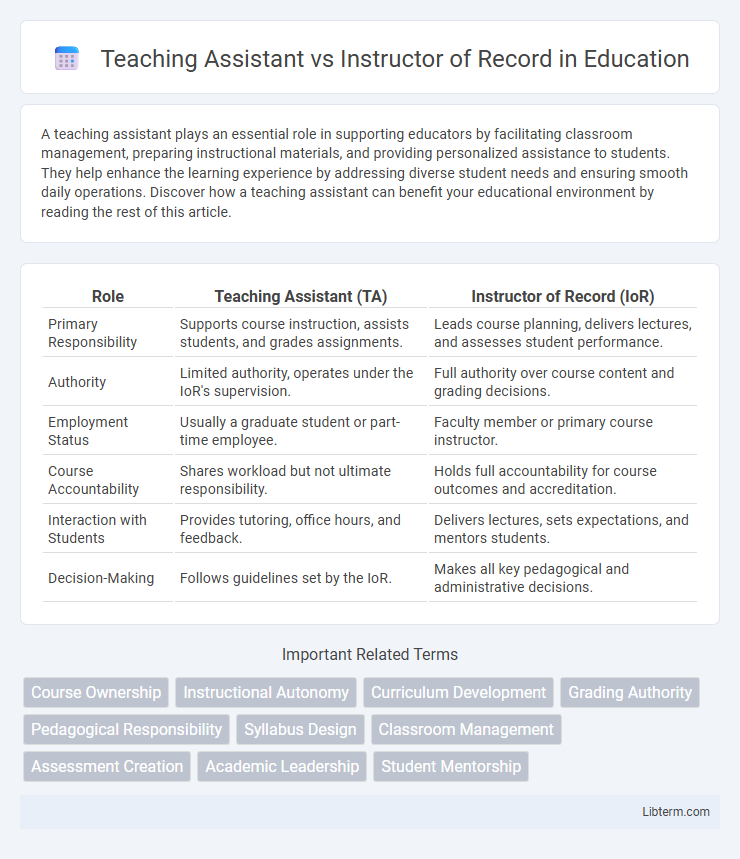A teaching assistant plays an essential role in supporting educators by facilitating classroom management, preparing instructional materials, and providing personalized assistance to students. They help enhance the learning experience by addressing diverse student needs and ensuring smooth daily operations. Discover how a teaching assistant can benefit your educational environment by reading the rest of this article.
Table of Comparison
| Role | Teaching Assistant (TA) | Instructor of Record (IoR) |
|---|---|---|
| Primary Responsibility | Supports course instruction, assists students, and grades assignments. | Leads course planning, delivers lectures, and assesses student performance. |
| Authority | Limited authority, operates under the IoR's supervision. | Full authority over course content and grading decisions. |
| Employment Status | Usually a graduate student or part-time employee. | Faculty member or primary course instructor. |
| Course Accountability | Shares workload but not ultimate responsibility. | Holds full accountability for course outcomes and accreditation. |
| Interaction with Students | Provides tutoring, office hours, and feedback. | Delivers lectures, sets expectations, and mentors students. |
| Decision-Making | Follows guidelines set by the IoR. | Makes all key pedagogical and administrative decisions. |
Introduction: Defining Teaching Assistant and Instructor of Record
A Teaching Assistant (TA) typically supports faculty by facilitating discussion sections, grading assignments, and providing student assistance under supervision. An Instructor of Record (IoR) holds primary responsibility for course design, delivery, assessment, and grading, officially recognized as the course's lead educator. Distinguishing these roles clarifies responsibilities in academic instruction and student engagement.
Key Responsibilities and Roles
Teaching Assistants primarily support course delivery by assisting with grading, facilitating discussions, and providing student support under the supervision of the Instructor of Record. The Instructor of Record holds full responsibility for curriculum design, assessment decisions, and maintaining academic standards throughout the course. Clear delineation of these roles ensures effective course management and promotes a productive learning environment.
Required Qualifications and Experience
Teaching Assistants typically require at least a bachelor's degree in the subject area and demonstrate strong communication and organizational skills, often gaining experience through prior tutoring or academic support roles. Instructors of Record generally need a master's degree or higher in the discipline, along with substantial teaching experience and a proven record of course development or curriculum management. University regulations often mandate formal certification or licensure for Instructors of Record to ensure accountability for grading and academic standards.
Classroom Authority and Autonomy
Teaching Assistants typically have limited classroom authority and operate under the direct supervision of the Instructor of Record, assisting with grading, leading discussion sections, and supporting instructional activities. The Instructor of Record holds full autonomy over course design, curriculum decisions, grading policies, and classroom management, ensuring academic standards and institutional compliance. This distinction in authority and autonomy impacts the scope of responsibilities and the level of decision-making power within the educational environment.
Interaction with Students
Teaching Assistants often provide more personalized support by facilitating small group discussions and offering one-on-one assistance, enhancing student engagement and comprehension. In contrast, Instructors of Record typically lead the overall course delivery, establishing the curriculum and grading standards while managing larger student populations. The dynamic interaction of Teaching Assistants complements the instructional authority of Instructors of Record, fostering a comprehensive learning environment.
Grading and Assessment Duties
Teaching Assistants typically support grading by evaluating quizzes, homework, and participation under the supervision of the Instructor of Record. Instructors of Record hold primary responsibility for creating, administering, and finalizing assessments, ensuring academic standards and grading consistency. Instructors also handle grade disputes and submit final grades to the institution, roles often beyond the scope of Teaching Assistants.
Course Planning and Material Development
Teaching Assistants primarily support instructors by facilitating discussions and grading, with limited involvement in course planning and material development. Instructors of Record hold full responsibility for designing course curriculum, developing instructional materials, and setting learning objectives. Their comprehensive role ensures academic standards are met and tailored content effectively addresses student needs.
Workload and Compensation
Teaching Assistants (TAs) typically manage grading, discussion sections, and administrative tasks, resulting in a lighter workload compared to Instructors of Record who design curriculum, deliver lectures, and assume full course responsibility. Compensation for TAs is usually hourly or stipend-based and significantly lower than Instructors of Record, who receive full-time or adjunct faculty salaries that reflect their extensive teaching and administrative duties. The disparity in workload and pay underscores the distinct roles and responsibilities each position holds within academic institutions.
Professional Development Opportunities
Teaching Assistants gain foundational experience through collaborative roles with Instructors of Record, often participating in curriculum delivery and student assessment under supervision. Instructors of Record hold full responsibility for course design, instruction, and evaluation, providing greater autonomy and leadership opportunities that enhance professional growth. Both roles contribute to career advancement, but Instructors of Record typically access broader professional development resources, including faculty workshops, grant writing, and conference presentations.
Choosing the Right Path: Factors to Consider
Choosing between a Teaching Assistant (TA) and an Instructor of Record (IoR) involves evaluating factors such as responsibility scope, teaching experience, and career goals. TAs typically support course delivery through grading and facilitating discussions, providing valuable hands-on experience with lower accountability. IoRs manage full course design, assessment, and student outcomes, offering a more comprehensive teaching role suited for those aiming for advanced academic positions.
Teaching Assistant Infographic

 libterm.com
libterm.com